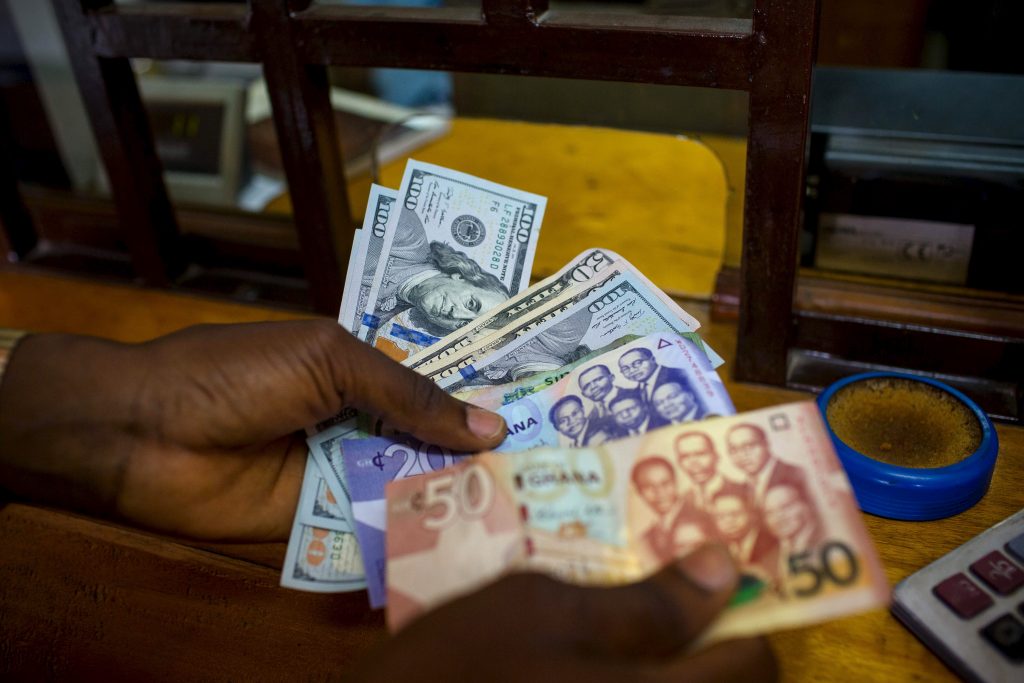Ghana Tightens Money, Stabilizes the Cedi
Ghana slows M2+ to 16.6% y/y; USDGHS=X steadies as disinflation advances. Frontier hard-currency risk compresses with EMB, but real credit remains negative and thin bank capital caps growth, keeping policy biased to the nominal anchor.

Ghana’s deceleration in broad money growth to 16.6 percent year-on-year in August 2025 marks a decisive turn in the post-crisis policy mix and a measurable restoration of monetary credibility. After a domestic debt exchange that reprofiled roughly GHS 130 billion of local obligations, the central bank has held the policy rate at 29 percent while interbank funding costs have hovered in the upper-20s, transmitting tight conditions through the banking system.
Reserve money growth has slowed to single digits, excess reserves have been drawn down via sterilization, and banks’ willingness to transform deposits into new lending has diminished. The aggregate signal is unambiguous: liquidity creation has slowed to a pace consistent with disinflation rather than reflation.
Transmission is clearest in the credit channel and the structure of deposits. Private-sector credit expanded about 11 percent in nominal terms over the same period, which implies a contraction in real terms against August inflation near 25 percent. Households and firms have rotated liquidity into short-duration government paper yielding the mid-20s, improving the sovereign’s domestic rollover profile but crowding out working-capital and capex lending.
Deposit composition has tilted toward demand balances rather than term funding, limiting banks’ capacity to originate multi-year credit and muting the financial accelerator that typically accompanies disinflation. Capital adequacy remains only modestly above regulatory floors after the restructuring, further constraining risk appetite and reinforcing a conservative stance on new lending.
Macro effects are visible in stabilising prices and a narrower trading band for the cedi, offset by slower investment. Nominal GDP growth is tracking the mid-teens for 2025, below the pre-pandemic average near the high-teens, consistent with a small negative output gap. Headline inflation, which peaked above 50 percent in early 2023, is trending toward the low-20s by year-end as tighter money suppresses import demand and second-round effects.
International reserves have steadied at about $6 billion, implying import cover in the low-to-mid three-month range, and forward premia on the currency have compressed as FX liquidity improves. These anchors reflect improved fiscal-monetary coordination: funding needs have become more predictable post-restructuring, and sterilization is no longer offset by unbounded deficit pressures.
Markets have recalibrated risk premia accordingly. The front end of the domestic curve remains elevated, but two-year yields trade below 91-day bills, a mild bull-flattening that signals confidence in disinflation without pricing imminent easing. In hard-currency space, broader emerging-market risk has compressed and Ghana’s complex has participated, with spreads converging toward the frontier cohort tracked by ETFs such as EMB. Local fixed income benefits from positive ex-post carry as disinflation advances, pulling domestic savings back into cedi assets and reducing the dollarization that intensified during the crisis. Equities remain selective, reflecting still-weak real credit and uncertain earnings leverage to an early-cycle recovery.
The structural constraints are unchanged and define the forward elasticity of growth. Bank capital buffers are thin, non-performing loans remain elevated in the mid-teens, and legacy energy-sector arrears continue to transmit quasi-fiscal risk into financial balance sheets. Without targeted bank re-capitalization and progress on utility cash-flow reforms, monetary discipline will stabilize prices and the currency but under-deliver on investment and employment. The policy task is to move from emergency stabilization to a configuration where real lending rates fall in tandem with inflation and term funding deepens, allowing private credit to turn positive in real terms without reigniting FX volatility.
Causality now runs from policy restraint to slower money, from slower money to weaker real credit, and from weaker real credit to cooler demand, a sequence that lowers inflation and compresses risk premia while capping the pace of capital formation. The economic signal to global investors is institutional: Ghana is prioritizing nominal stability, rebuilding the policy anchor, and differentiating itself from peers still wrestling with fiscal dominance. Duration exposure benefits from the disinflation path and carry; credit and equities require evidence that banks can intermediate growth rather than merely finance the sovereign.
The outlook is testable on a defined timetable. If year-over-year M2+ growth holds in the mid-teens, reserve money stays in single digits, USDGHS=X volatility remains contained, and private-sector credit turns positive in real terms by the second half of 2026, headline inflation should drift below 20 percent in early 2026 and local duration should extend its outperformance. Concurrent gains in bank capital ratios and a sustained decline in NPLs would confirm the transition from stabilization to early-cycle recovery. Absent those markers, the curve will retain a defensive posture, growth will underperform potential, and policy will remain biased toward maintaining the nominal anchor over accelerating the real economy.





